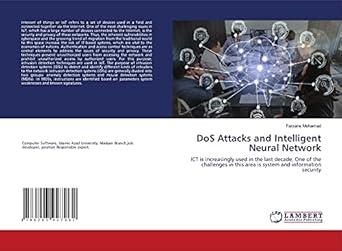کتاب DoS Attacks and Intelligent Neural Network
۱۴۰,۰۰۰ تومان Original price was: ۱۴۰,۰۰۰ تومان.۱۰۱,۳۶۰ تومانCurrent price is: ۱۰۱,۳۶۰ تومان.
| تعداد صفحات | 51 |
|---|---|
| شابک | 978-620-3-92796-2 |
| انتشارات |

کتاب DoS Attacks and Intelligent Neural Network – چالشها و راهکارهای نوین
کتاب DoS Attacks and Intelligent Neural Network یک اثر تخصصی است که به بررسی حملات منع سرویس (DoS) و استفاده از شبکههای عصبی هوشمند برای مقابله با این تهدیدات سایبری میپردازد. این کتاب رویکردهای پیشرفتهای را برای تحلیل، شناسایی و کاهش اثرات این نوع حملات در دنیای دیجیتال ارائه میدهد.
درباره کتاب DoS Attacks and Intelligent Neural Network
این کتاب با تمرکز بر اهمیت امنیت سایبری، به طور خاص حملات DoS و تأثیرات گسترده آنها بر زیرساختهای فناوری اطلاعات را مورد بررسی قرار میدهد. نویسنده در این اثر بهکارگیری الگوریتمهای هوش مصنوعی، بهویژه شبکههای عصبی، برای شناسایی الگوهای حمله و ارائه راهکارهای هوشمند در جهت افزایش امنیت سیستمها را تشریح کرده است.
موضوعات کلیدی کتاب
- مبانی حملات DoS: تعریف، انواع و چگونگی عملکرد این حملات سایبری.
- پیامدهای حملات DoS: بررسی خسارات و تأثیرات بر سازمانها و زیرساختهای حیاتی.
- شبکههای عصبی هوشمند: معرفی فناوریهای مبتنی بر هوش مصنوعی و کاربرد آنها در امنیت سایبری.
- روشهای پیشگیری: ارائه راهکارهای عملی برای شناسایی و کاهش خطرات مرتبط با حملات DoS.
- آینده امنیت سایبری: نقش فناوریهای هوشمند در مقابله با تهدیدات پیشرفته.
ویژگیهای برجسته کتاب
- تخصصی و جامع: این کتاب تمامی جنبههای مرتبط با حملات DoS و نقش شبکههای عصبی را پوشش میدهد.
- رویکرد عملی: ارائه مثالها و سناریوهای واقعی برای درک بهتر مفاهیم.
- مبتنی بر فناوریهای نوین: بررسی نقش هوش مصنوعی و شبکههای عصبی در دنیای امنیت سایبری.
- زبان علمی و دقیق: مناسب برای دانشجویان، محققان و متخصصان حوزه امنیت اطلاعات.
چرا کتاب DoS Attacks and Intelligent Neural Network را بخوانید؟
این کتاب به شما دیدی عمیق در مورد یکی از بزرگترین تهدیدات امنیت سایبری و راههای مقابله با آن ارائه میدهد. اگر علاقهمند به یادگیری تکنیکهای پیشرفته در زمینه امنیت اطلاعات هستید یا به دنبال بهکارگیری فناوریهای هوشمند در کاهش تهدیدات سایبری هستید، این کتاب منبعی ارزشمند برای شما خواهد بود.
مخاطبان کتاب
- دانشجویان علوم کامپیوتر: بهویژه افرادی که در زمینه امنیت سایبری و هوش مصنوعی تحصیل میکنند.
- متخصصان امنیت اطلاعات: برای ارتقای دانش و مهارتهای تخصصی در مقابله با حملات سایبری.
- پژوهشگران هوش مصنوعی: جهت بررسی کاربردهای جدید شبکههای عصبی در امنیت سایبری.
- مدیران فناوری اطلاعات: برای درک بهتر تهدیدات و پیادهسازی راهکارهای هوشمند در سازمانها.
سفارش کتاب DoS Attacks and Intelligent Neural Network
برای تهیه این کتاب تخصصی و آشنایی با روشهای پیشرفته در مقابله با حملات سایبری، همین حالا سفارش خود را ثبت کنید. این اثر میتواند ابزاری کلیدی برای تقویت امنیت سیستمهای شما باشد.
پرسش و پاسخ برای کتاب “DoS Attacks and Intelligent Neural Network”
1. حملات DoS چیست؟
حملات Denial of Service (DoS) به حملاتی اطلاق میشود که هدف آنها ایجاد اختلال یا از کار انداختن سرویسهای شبکه است. در این حملات، منابع شبکه مانند پهنای باند یا سرورهای سیستم به طوری اشباع میشوند که کاربران قانونی قادر به استفاده از آنها نخواهند بود. 💻
2. فایروال چیست و چه نقشی در جلوگیری از حملات دارد؟
فایروال یک سیستم امنیتی است که شبکه را از ترافیک غیرمجاز محافظت میکند. فایروالها میتوانند ترافیک ورودی و خروجی را فیلتر کرده و تنها اجازه عبور ترافیک معتبر را بدهند. 🛡️
3. سیستم تشخیص نفوذ (IDS) چیست؟
سیستم تشخیص نفوذ (IDS) سیستمی است که به منظور شناسایی رفتارهای غیرعادی یا تهدیدات امنیتی در شبکه طراحی شده است. این سیستمها میتوانند حملات را شناسایی کرده و هشدارهای امنیتی ارسال کنند. 🚨
4. انواع سیستمهای IDS چیست؟
سیستمهای IDS به طور کلی به دو دسته تقسیم میشوند:
- NIDS (Network-based IDS): نظارت بر شبکه برای شناسایی حملات.
- HIDS (Host-based IDS): نظارت بر یک میزبان خاص برای شناسایی حملات.
در این کتاب، انواع مختلف این سیستمها بررسی شدهاند. 🔍
5. شبکههای عصبی مصنوعی (ANNs) چیست؟
شبکههای عصبی مصنوعی (ANNs) سیستمهایی هستند که به الگوریتمهای یادگیری ماشینی متکی هستند و میتوانند الگوها را شبیهسازی کرده و تصمیمات هوشمندانهتری اتخاذ کنند. این شبکهها در بسیاری از مسائل امنیت سایبری، از جمله شناسایی حملات، کاربرد دارند. 🧠
6. روش پیشنهادی در این کتاب چیست؟
روش پیشنهادی در کتاب ترکیب شبکههای عصبی مصنوعی با تکنیکهای مختلف برای شناسایی حملات DoS است. این تکنیکها به صورت تخصصی برای تجزیه و تحلیل دادهها و شناسایی الگوهای حملاتی طراحی شدهاند. ⚙️
7. مجموعه دادههای مورد استفاده در تحقیق چیست؟
در این تحقیق از مجموعه دادههای KDD استفاده شده است که برای شبیهسازی حملات و آزمایش الگوریتمها به کار میرود. این مجموعه داده شامل ویژگیهای مختلف شبکه مانند نوع پروتکل، طول بستهها، و زمان پاسخ است. 📊
8. ارزیابی تکنیکها چگونه انجام میشود؟
برای ارزیابی تکنیکها، معیارهای مختلفی مانند دقت (Accuracy)، ماتریس اشتباهات (Confusion Matrix) و نرخ خطا بررسی میشود تا عملکرد الگوریتمها در شناسایی حملات DoS ارزیابی گردد. 📈
9. تفاوت تکنیکهای مختلف در این تحقیق چیست؟
در این تحقیق، تکنیکهای مختلفی مانند CNN (Convolutional Neural Networks)، RNN (Recurrent Neural Networks) و LSTM (Long Short-Term Memory) با یکدیگر مقایسه شدهاند. هر کدام از این تکنیکها نقاط قوت و ضعف خاص خود را دارند که در نتایج مقایسه نشان داده شده است. 🤖
10. کاربردهای این تحقیق چیست؟
این تحقیق میتواند در بهبود سیستمهای امنیتی شبکههای کامپیوتری، شناسایی خودکار حملات DoS و بهبود دقت در سیستمهای تشخیص نفوذ مفید باشد. همچنین، میتواند در توسعه ابزارهای هوش مصنوعی برای امنیت سایبری کاربرد داشته باشد. 🌐
11. آیا استفاده از شبکههای عصبی در مقابله با حملات DoS موثر است؟
بله، استفاده از شبکههای عصبی مصنوعی به دلیل توانایی آنها در شناسایی الگوها و تحلیل دادههای پیچیده، میتواند در مقابله با حملات DoS بسیار مؤثر باشد. این روشها میتوانند حملات را با دقت بالا شناسایی کنند. 🔒
12. نتایج مقایسه تکنیکها چگونه بود؟
در مقایسه تکنیکها، نتایج نشان داد که مدلهای LSTM و BiLSTM (Bidirectional LSTM) بهترین عملکرد را در شناسایی حملات DoS داشتهاند و به دقت بالاتری نسبت به دیگر تکنیکها دست یافتهاند. 📉
13. چه عواملی بر دقت سیستمهای IDS تأثیرگذار است؟
عوامل مختلفی از جمله کیفیت دادهها، نوع تکنیکهای استفاده شده، و قابلیت سیستمهای IDS در یادگیری الگوها بر دقت آنها تأثیر دارند. استفاده از تکنیکهای پیشرفته مانند شبکههای عصبی میتواند دقت را افزایش دهد. ⚡
14. کاربردهای شبکههای عصبی در امنیت سایبری چیست؟
شبکههای عصبی در امنیت سایبری برای شناسایی حملات، پیشبینی تهدیدات، و بهبود دقت سیستمهای تشخیص نفوذ و فایروالها به کار میروند. این تکنیکها میتوانند حملات پیچیدهای که توسط روشهای سنتی شناسایی نمیشوند را شبیهسازی کنند. 🔐
این پرسشها و پاسخها میتواند به خوانندگان کمک کند تا به درک بهتری از مفاهیم موجود در کتاب “DoS Attacks and Intelligent Neural Network” دست یابند و کاربردهای آنها را در زمینه امنیت سایبری و تشخیص حملات بشناسند.
| تعداد صفحات | 51 |
|---|---|
| شابک | 978-620-3-92796-2 |
| انتشارات |
محصولات مشابه
-
کتاب An Introduction to Zero-Energy Building
۱۵۴,۰۰۰ تومانOriginal price was: ۱۵۴,۰۰۰ تومان.۱۱۱,۴۹۶ تومانCurrent price is: ۱۱۱,۴۹۶ تومان. -
کتاب Determination of Changing Expression of miR-212 and EGFR Genes
۱۶۸,۰۰۰ تومانOriginal price was: ۱۶۸,۰۰۰ تومان.۱۱۸,۹۴۴ تومانCurrent price is: ۱۱۸,۹۴۴ تومان. -
کتاب Mental and physical health
۱۷۸,۰۰۰ تومانOriginal price was: ۱۷۸,۰۰۰ تومان.۱۲۶,۰۲۴ تومانCurrent price is: ۱۲۶,۰۲۴ تومان.






